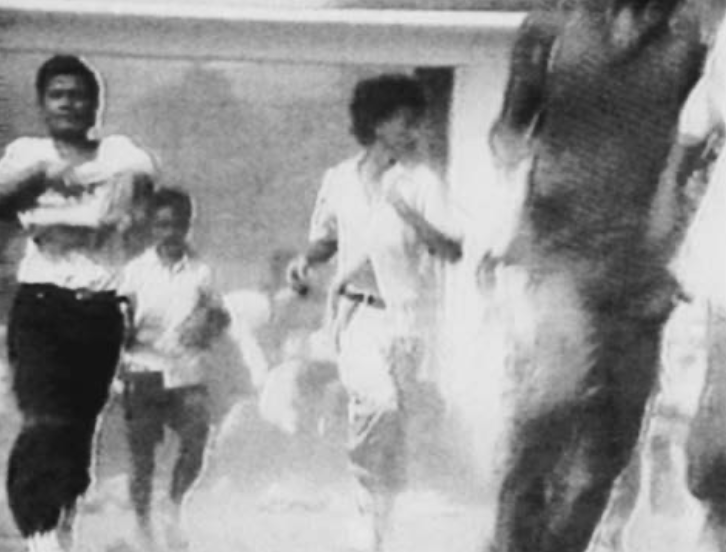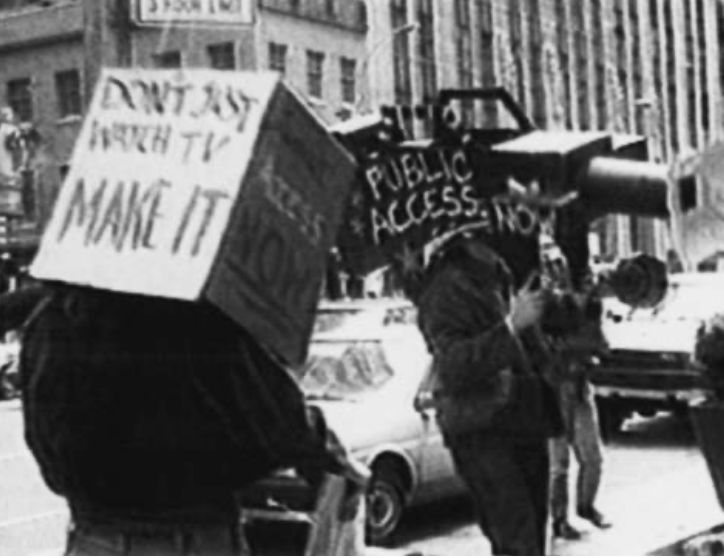Activist Television
Activist Television
Paper Tiger Television Courtesy of Paper Tiger TV Collective
Although it has antecedents in earlier print, radio, and film activism, activist television first arose in the late 1960s. A confluence of technological and social factors inspired activists of that era to use television as a tool for political, social, and cultural change. The advent of consumer video cameras, cable television, and video recorders/players opened up new possibilities in televi- sion production and distribution. Ordinary people could use inexpensive, portable production equipment to make their own messages in the video medium. Public access cable channels and consumer VCRs provided the means of viewing these messages. The growth of contemporaneous social movements and the founding of a new documentary tradition also spurred the rise of activist television. The New Left, the women’s move- ment, and the civil rights movement all recognized the value of using television to communicate to their mem- bers and the society at large. In addition, a broad movement for participatory democracy advocated citizen in- volvement in public policy formation and access to the media. Participatory democrats thought that popular media, including television, should play a role in mobi- lizing people, disseminating in formation, and improv- ing political and social life. At the same time, a new documentary tradition, known as “community media,” began using film and video as a tool for political orga- nizing within communities and for conveying commu- nity concerns to government authorities.


Paper Tiger Television.
Courtesy of Paper Tiger TV Collective
Paper Tiger Television.
Courtesy of Paper Tiger TV Collective
Bio
Over the years, various media-centered groups have attempted to use television for activism. Media scholars have called the resulting media by various names, including grassroots or community television, guerilla television, radical alternative television, and advocacy video. Differing mainly in their relative emphasis on a range of strategies and goals for media activism, these groups share an overarching interest in TV as a catalyst for change, a medium for community expression, and a forum for democratic communication and representation.
The Canadian “Challenge for Change” project of the late 1960s and early 1970s was an early impetus for activist television. Grounded in the Canadian social democratic tradition and funded by the Canadian government and National Film Board, the project established and refined the concept of community media. Hoping to increase citizen involvement in social and cultural development, “Challenge for Change” sent video makers into impoverished or socially troubled locales to train already active citizens groups to communicate their needs. These groups used video to help establish community leaders, prioritize social agendas, tell their stories, catalyze local action, and demand better government programs and services. In its later years, the project promoted the creation of community video centers. A former executive producer on the project, George Stoney, cofounded the Alternative Media Center in New York in the early 1970s and began advocating for the establishment of community television in the United States and for public access cable television as a means of distributing community programming. Today, community television often stresses local outreach, organization, and participation; direct expression unmediated by industry professionals; and small scale, locally based initiatives and projects. This model of television activism has analogs in many other parts of the world, including Aboriginal community television in Australia, TV Maxambomba from the marginalized and impoverished neighborhoods of Rio de Janeiro, Brazil, and Video SEWA, produced by working women in Ahmedabad, India, to name a few.
Guerilla television groups in the United States were another impetus for activist television. Video collectives, such as Global Village, Videofreex, People’s Video Theater, and Raindance, sought to use new technologies to create a more democratic and Utopian society. In the book Guerilla Television, Michael Shamberg of the Raindance collective laid out his ideas for the philosophy and practice of activist media. The book, which became known in the United States as the “Bible” of guerilla media, covered a range of issues, including the dynamics of the information economy, the nature of media bias, and practical tips on video production. Shamberg criticized the undemocratic, centralized, and monotonous character of the mainstream media and proposed a re-democratization of the media through political and cultural guerilla warfare waged with video, cable TV, and computers.
Activist television today also finds expression in radical alternative television and advocacy video projects. Radical alternative television includes noncommercial and noncorporate media that have a content, aesthetics, and organization that is fundamentally different from the mainstream media. These media ad- dress topics and represent viewpoints often excluded from mainstream television, sport a visual look that purposefully defies televisual norms and conventions, and adhere to a more democratic though less efficient and professionalized production process. In addition, these videos place their audience in a different relationship to the product they’re viewing, often aiming at smaller and more specific audiences than their main- stream counterparts. Radical alternative television projects are activist in that they pose challenges to dominant power structures, give voice to diverse communities and classes, enable like-minded groups to speak to one another, and aim to move and motivate their viewers. U.S. projects in this vein include: Paper Tiger Television, a video collective that produces a series of media critiques that deconstruct both the con- tent and aesthetic of conventional media; Labor Beat, a news and public affairs show that covers labor issues for working people; and Dyke TV, a show made by and for lesbians.
Advocacy video refers to the production of works closely connected to specific political campaigns. These videos aim to motivate people to take direct action on issues such as environmental protection, human rights, animal rights, and corporate responsibility. Often in the form of short documentaries, advocacy videos focus on a particular problem intending to evoke a response, initiate debate, build constituencies, and shape legislation. There are many successful examples of advocacy video. The United Farm Workers video, No Grapes (1992), was part of an effective campaign to boycott California table grapes and ultimately to restrict the use of harmful pesticides. Not in Our Town (1995), a film produced in response to a series of hate crimes in Billings, Montana, was part of a national initiative to fight hate crimes. Deadly Deception (1991), an Academy Award–winning documentary de- signed to hold the General Electric (GE) corporation responsible for the health effects of its nuclear production facilities, helped win a drive to push GE out of the nuclear weapons business.
The ability to produce activist television has in- creased with developments in technology. In the 1980s, relatively cheap and lightweight video cameras became available. In the 1990s, digital formats and computer-based editing substantially reduced the time and cost of postproduction. These developments are beginning to erode the gap in production values be- tween mainstream media and activist television. Although the means of production has become widely available, the same cannot be said for distribution. Activist television is largely excluded from mainstream broadcast and cable television channels. Since the late 1960s and early 1970s in the United States, public access cable television has been a primary source of distribution for activist television, but these channels are hard-won concessions obtained from cable operators by cities during cable franchise negotiations. The diffusion of home videocassette recorders/players in the 1970s and 1980s offered another avenue for viewing this mode of television. Both public access cable and VCRs require that producers distribute individual tapes to potential audiences and programmers. Since the 1980s, there have been some notable efforts to distribute activist television more efficiently and broadly by satellite. Deep Dish TV Network began using satellite in the mid-1980s to deliver activist programming to public access stations and home dish owners around the United States. In 2000 Free Speech TV began its own channel for activist-oriented programming on the direct broadcast satellite system the Dish Network.
The Internet is the newest frontier for activist television distribution. Numerous activist groups have put the Internet to innovative uses. Free Speech TV uses the World Wide Web to stream program segments, provide additional information on program topics, coordinate discussion forums, and connect viewers with activist organizations. The Witness program works with partner groups in 50 countries to produce and distribute short advocacy videos on human rights abuses. Internet users can view Witness program videos on the Internet that deal with such topics as state-supported executions in Jamaica, police abuse and torture in Tamil Nadu, India, and the women’s right movement in Afghanistan. Independent Media Centers (IMCs) may constitute the most ambitious use of the Internet for both local and global activism. Since the establishment of the first IMC in Seattle in 1999, over 100 others have sprung up throughout the world, including Africa; Canada; Europe; Latin America; the Pacific; and South, East, and West Asia. IMCs provide activists interested in initiating debate, spreading in formation and analysis, and organizing political action with open forums for the distribution of video and other media online. IMC activists frequently couple online with established offline methods of video distribution to achieve maximum circulation of their work.

